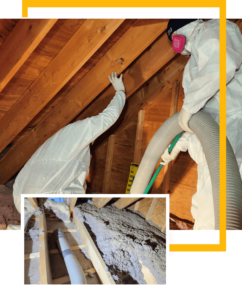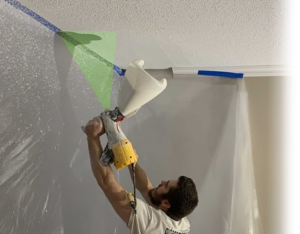Insulation Removal is a messy and time-consuming project. It also requires the right equipment to be safe and efficient.
Start with a thorough inspection of the attic space and existing insulation. This will help you determine the type and condition of the insulation. Contact Perth Insulation Remover now!

Clear attic storage items and seal off the area to prevent contamination. Protective clothing and a respirator mask are essential.
Insulation removal is a messy job, and it’s important to prepare before starting the process. It’s a good idea to wear protective clothing and equipment such as gloves, face masks, and goggles. This will help protect you from insulation fibers and dust. You should also wear a sturdy ladder or scaffolding to access your attic, and you’ll need heavy-duty garbage bags to dispose of the old insulation. If your home has blown-in insulation, you’ll need to prepare the space by removing surface coverings inside your attic and vaccuming the area before beginning.
If your attic insulation has been installed with spray foam, you’ll need to use a special machine designed to remove this type of material. You’ll need to rent this equipment, and it’s best to have a helper to monitor the operation of the vacuum. This is an expensive project and should only be undertaken by professionals with experience in the process.
It’s also a good idea to clear out any attic or crawlspace clutter and remove any items stored in the area before you start removing insulation. This will make it easier to move around during the process and avoid damaging anything. You should also turn off and disconnect any electrical systems in your attic before beginning the work. This will minimize the risk of working around live wires and reduce the chances of damage or injuries.
Before you begin removing attic insulation, it’s important to check for any signs of pest infestation. Mice and rats can chew through insulation, leaving behind contaminated fecal matter that can spread disease in your home. You should also look for any visible mold spots in the attic, which is a sign of moisture problems.
If you see any of these signs, it’s a good idea to consider having your insulation removed and replaced with new materials. This will improve your home’s energy efficiency, reduce your utility costs, and create a cleaner, healthier indoor environment. In addition, it’s essential to consider your budget and determine how much you can afford to spend on this renovation.
Removal
Insulation is an important part of your home’s comfort and energy efficiency, but over time it can become damaged. This can be due to pest infestation, mold growth, or damage caused by general wear and tear. When this happens it is important to have your insulation removed and replaced so that your home can continue to be safe and comfortable for your family.
Although you can choose to do insulation removal yourself, it is highly recommended that you hire a local insulation company with years of experience. This will eliminate the risk of pest infestation, health hazards and other issues that may occur during the process. Additionally, many professional insulation companies offer disposal services, eliminating the need to buy and maintain expensive equipment.
The first step in the insulation removal process is to prepare the area. This includes clearing out any items and ensuring that there is clear access to the attic. It is also a good idea to make sure that any electrical wires are disconnected and out of the way. This will prevent the risk of electric shock and fire during the process.
Once the area is cleared it’s time to start removing the old insulation. This can be a messy and frustrating project, so it’s important to have a plan before you begin. It’s also a good idea to wear protective gear when working with insulation, as it can be hazardous. Fiberglass batt insulation, for example, contains small glass fibers that can cause skin irritation and itching. It’s also a good idea for homeowners to wear safety glasses and a face mask to protect themselves from dust and other airborne contaminants.
Loose-fill insulation is typically made of materials like cellulose or fiberglass, and it can be difficult to remove without the proper equipment. Ideally, homeowners should use a vacuum with a specialized attachment to remove loose-fill insulation from walls and attics. However, if this isn’t possible, a large plastic bag can be used to collect the material, minimizing the amount of mess created during the process. The removed insulation should be disposed of in accordance with local regulations.
Disposal
Insulation removal is a messy job, and it is important to take precautions during this process to minimize the spread of particles and fibers throughout your home. To do this, it is important to properly prepare the workspace before beginning removal and follow strict safety protocols. It is also essential to seal off the area and prevent debris from escaping during this process, which can cause health hazards if inhaled.
In addition, it is necessary to follow local regulations regarding disposal of old insulation materials. This includes identifying which types of materials are considered hazardous and where they must be taken for disposal. Professional services are well-versed in these local regulations and can ensure that all waste is disposed of correctly, protecting property owners from potential legal consequences.
Once the old insulation has been removed, professionals will thoroughly clean and decontaminate the attic space to remove any contaminants or harmful substances. This process can be time-consuming and may require specialized equipment and tools to prevent spreading dust and particles into other areas of the home.
After the attic space is cleaned, the professionals will prepare the area for new insulation installation. This process will vary depending on the type of insulation chosen, and it may involve cutting and fitting materials to fit the attic space. Professionals will also ensure that any air leaks are properly sealed to prevent cold or hot spots in the home.
During this process, it is important to identify and address any issues that may have occurred during the removal process, such as mold or pests. This will help to ensure the proper and efficient installation of new insulation, as well as protect your home from these problems in the future.
Insulation removal can be a challenging project for homeowners, but it is important to work with experienced and trusted professionals. Hiring a professional company can ensure that the job is done correctly and efficiently, saving homeowners from the headaches and costs of trying to do it themselves. Hiring a reputable professional will also ensure that the proper steps are taken to safely dispose of and recycle the insulation materials, reducing environmental hazards and waste.
Safety
Taking proper safety measures during insulation removal ensures an efficient process and prevents property damage. Clearing the workspace, sealing off areas of the attic with plastic sheeting, and establishing a designated area for debris disposal are essential steps to take before beginning the work. In addition, wearing proper personal protective equipment (PPE) helps prevent inhalation of harmful particles and safeguards the skin against irritants and allergens. PPE should include gloves, a mask, and goggles. Regularly checking and cleaning the gear can also improve its efficiency.
If you are planning to replace old insulation with new material, you should consider hiring a professional service that has the experience and specialized equipment necessary for effective installation. A qualified contractor can quickly and efficiently complete the job, saving you time and money. You can find a trustworthy contractor by researching online reviews, asking for referrals from friends and family, and consulting local business directories.
Before attempting insulation removal, you should turn off the power and disconnect any live wires in the attic. Contact with live wires can cause electric shock and fire hazards. This step is vital for ensuring the safety of everyone involved in the project, preventing damage to electrical systems, and protecting against potential injuries and accidents.
Loose-fill insulation can be a dangerous and messy material to handle. It is important to wear proper clothing and equipment to protect yourself from inhalation of insulation particles, dust, and other contaminants. Wearing disposable coveralls, gloves, a mask, and goggles is an effective way to minimize your risk of injury. In addition, you should use a ladder or scaffolding to gain access to the attic and avoid tripping or falling over items in the workspace.
Spray foam insulation is a more difficult material to remove due to its adhesive properties and rigid structure. It is best to hire a trained professional for this type of insulation removal, as improper handling can result in serious injuries or property damage. Hiring a professional for spray foam insulation removal also ensures that the material is recycled or disposed of according to environmental guidelines.
